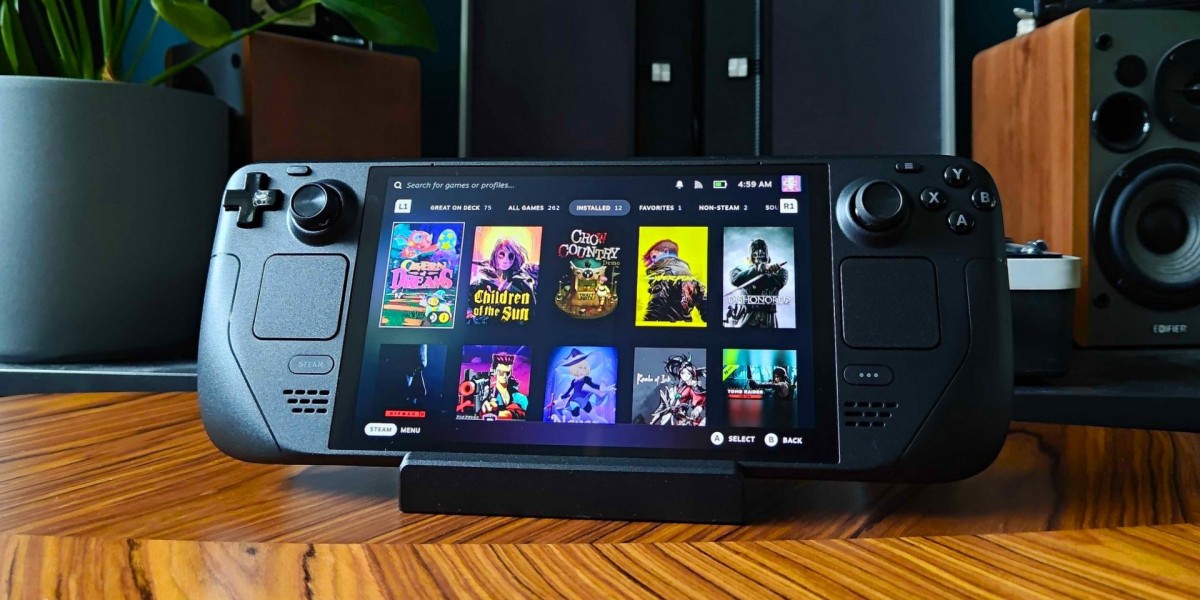The Steam Deck has quickly become one of the most talked-about devices in the gaming world. Designed by Valve, it brings the power of a gaming PC into a handheld console, giving players the freedom to enjoy their favorite titles anywhere.
Unlike traditional handheld consoles, the Steam Deck runs on SteamOS and can play thousands of PC games directly from the Steam library. With its custom hardware, it delivers performance close to mid-range gaming laptops in a compact form.
For gamers who value flexibility, the Steam Deck is more than just a handheld. It supports mods, accessories, and even allows installation of other operating systems, making it one of the most versatile gaming devices available today.
Steam Deck Design and Build Quality
The Steam Deck is built with a sleek yet durable design that ensures comfort during extended gaming sessions. Its ergonomic shape, button placement, and joystick positioning make it suitable for both casual and hardcore players. The screen is a 7-inch touchscreen with a 1280x800 resolution, offering clear visuals for most modern games.
Despite its compact look, the Steam Deck is slightly larger than a Nintendo Switch, but it compensates with better hardware and features. Valve designed the console with air vents and a cooling system to handle high-performance gaming without overheating.
The device also comes with trackpads for precise controls, something rare in handheld gaming. Overall, the Steam Deck combines sturdy construction with smart ergonomics, giving gamers a comfortable yet powerful portable device.
Steam Deck Performance and Hardware
Under the hood, the Steam Deck runs on a custom AMD APU designed for handheld gaming. It features a Zen 2 CPU with RDNA 2 graphics, making it capable of running AAA titles smoothly. Gamers can choose between 64GB eMMC, 256GB NVMe SSD, and 512GB NVMe SSD versions depending on storage needs.
Performance-wise, the Steam Deck handles popular titles like Elden Ring, Cyberpunk 2077, and Apex Legends at respectable frame rates. Its hardware is optimized to balance power and battery life, ensuring players get both portability and performance.
The device also supports expandable storage via microSD cards, giving users more room for larger games. With its hardware, the Steam Deck positions itself as a portable PC rather than just another handheld console.
Steam Deck Operating System and Software
The Steam Deck runs on SteamOS, a Linux-based system designed for gaming. It comes preloaded with the Steam library, allowing players to access thousands of titles instantly. The interface is optimized for touch and controller navigation, making it simple to browse and launch games.
One of the Steam Deck’s biggest strengths is flexibility. Users can install Windows or other operating systems if they prefer. This means the device can run non-Steam launchers like Epic Games, Xbox Game Pass, or even emulators for retro gaming.
Valve continuously updates SteamOS, improving compatibility and adding new features. The software experience is designed to give players the same freedom they’d have on a desktop PC, but in a portable form factor.
Steam Deck Game Library and Compatibility
One of the strongest advantages of the Steam Deck is its massive game library. Since it’s tied directly to Steam, players can instantly access their existing collection. From indie favorites to high-end AAA releases, the Steam Deck is designed to run them all.
Valve introduced a “Deck Verified” system to ensure smooth compatibility. Games are tested and marked as Verified, Playable, or Unsupported, helping users know what to expect before installing. Many developers are also optimizing their titles for the Steam Deck.
Additionally, the device supports mods and customizations, allowing gamers to enhance their experience. With such broad compatibility, the Steam Deck makes PC gaming portable without sacrificing game variety or quality.
Steam Deck Accessories and Docking Options
The Steam Deck supports a wide range of accessories, making it more versatile than other handhelds. Players can connect controllers, keyboards, mice, and even external displays. Valve also released an official docking station, allowing the Steam Deck to function like a desktop PC when connected to a monitor or TV.
Third-party docks and hubs are also compatible, giving players more flexibility. This opens the door for couch gaming, competitive setups, or even using the Steam Deck as a work device.
Accessories like carrying cases, protective covers, and screen protectors add extra convenience. With the right setup, the Steam Deck transforms from a handheld console into a complete gaming PC, offering unmatched flexibility.
Steam Deck Battery Life and Charging
Battery life is one of the most discussed aspects of the Steam Deck. Depending on the game, it can last anywhere from 2 to 8 hours on a single charge. Lighter games and indie titles consume less power, while demanding AAA games drain the battery faster.
The Steam Deck charges via USB-C, supporting fast charging for quick top-ups. Players who travel frequently may want to invest in a portable power bank for extended sessions.
Valve also provides battery optimization settings, letting users adjust performance levels to extend playtime. While it may not match traditional handheld consoles in battery life, the Steam Deck offers enough flexibility to balance power and portability.
Steam Deck Price and Availability
The Steam Deck comes in three different models: 64GB, 256GB, and 512GB, each priced according to storage capacity. The base model is affordable but slower due to eMMC storage, while the higher-end versions include faster SSDs for quicker load times.
Since its launch, demand for the Steam Deck has been high, leading to occasional shortages. Valve continues to scale production to meet global demand. Pricing remains competitive compared to gaming laptops, making it a cost-effective option for portable PC gaming.
Considering its hardware, flexibility, and performance, the Steam Deck provides excellent value. For gamers who want PC-level gaming on the go, it’s a worthy investment.
Steam Deck Future and Community Support
The Steam Deck has built a strong community since its release. Gamers share mods, settings, and customization tips online, making the experience even better. Valve also listens to community feedback, regularly updating both hardware and software support.
Future improvements may include updated models, better battery efficiency, and expanded compatibility with non-Steam platforms. With such strong backing, the Steam Deck is more than a passing trend it’s shaping the future of portable gaming.
Its popularity has also encouraged developers to optimize their games for the device. As more updates roll out, the Steam Deck’s role as a handheld PC will only grow stronger.
FAQs About Steam Deck
Can the Steam Deck play all PC games?
Not all, but most. Valve’s “Deck Verified” system ensures players know which games run smoothly. Many AAA and indie games are optimized for the Steam Deck.
Can I install Windows on the Steam Deck?
Yes, users can install Windows or other operating systems, making the Steam Deck function like a full PC.
How long does the Steam Deck battery last?
It lasts 2–8 hours depending on the type of game being played and performance settings.
Is the Steam Deck worth buying?
For gamers who want PC-level performance in a handheld form, the Steam Deck is an excellent choice.
Does the Steam Deck support external monitors?
Yes, through its USB-C port or official dock, it can connect to monitors, TVs, and other peripherals.








